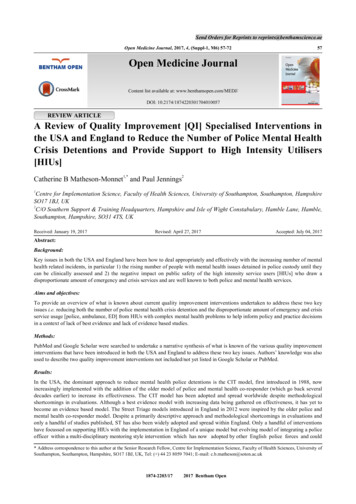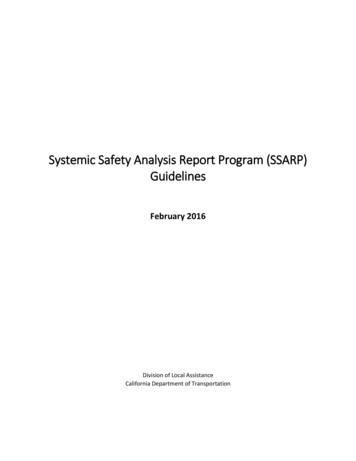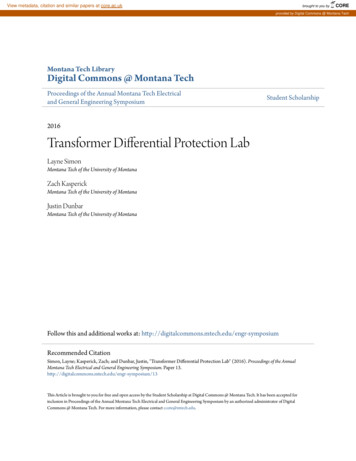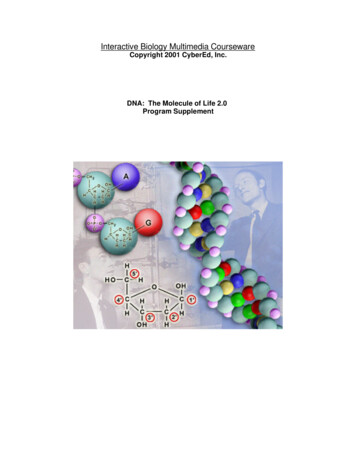
Transcription
Send Orders for Reprints to reprints@benthamscience.aeOpen Medicine Journal, 2017, 4, (Suppl-1, M6) 57-7257Open Medicine JournalContent list available at: www.benthamopen.com/MEDJ/DOI: 10.2174/1874220301704010057REVIEW ARTICLEA Review of Quality Improvement [QI] Specialised Interventions inthe USA and England to Reduce the Number of Police Mental HealthCrisis Detentions and Provide Support to High Intensity Utilisers[HIUs]Catherine B Matheson-Monnet1,* and Paul Jennings21Centre for Implementation Science, Faculty of Health Sciences, University of Southampton, Southampton, HampshireSO17 1BJ, UK2C/O Southern Support & Training Headquarters, Hampshire and Isle of Wight Constabulary, Hamble Lane, Hamble,Southampton, Hampshire, SO31 4TS, UKReceived: January 19, 2017Revised: April 27, 2017Accepted: July 04, 2017Abstract:Background:Key issues in both the USA and England have been how to deal appropriately and effectively with the increasing number of mentalhealth related incidents, in particular 1) the rising number of people with mental health issues detained in police custody until theycan be clinically assessed and 2) the negative impact on public safety of the high intensity service users [HIUs] who draw adisproportionate amount of emergency and crisis services and are well known to both police and mental health services.Aims and objectives:To provide an overview of what is known about current quality improvement interventions undertaken to address these two keyissues i.e. reducing both the number of police mental health crisis detention and the disproportionate amount of emergency and crisisservice usage [police, ambulance, ED] from HIUs with complex mental health problems to help inform policy and practice decisionsin a context of lack of best evidence and lack of evidence based studies.Methods:PubMed and Google Scholar were searched to undertake a narrative synthesis of what is known of the various quality improvementinterventions that have been introduced in both the USA and England to address these two key issues. Authors’ knowledge was alsoused to describe two quality improvement interventions not included/not yet listed in Google Scholar or PubMed.Results:In the USA, the dominant approach to reduce mental health police detentions is the CIT model, first introduced in 1988, nowincreasingly implemented with the addition of the older model of police and mental health co-responder (which go back severaldecades earlier) to increase its effectiveness. The CIT model has been adopted and spread worldwide despite methodologicalshortcomings in evaluations. Although a best evidence model with increasing data being gathered on effectiveness, it has yet tobecome an evidence based model. The Street Triage models introduced in England in 2012 were inspired by the older police andmental health co-responder model. Despite a primarily descriptive approach and methodological shortcomings in evaluations andonly a handful of studies published, ST has also been widely adopted and spread within England. Only a handful of interventionshave focussed on supporting HIUs with the implementation in England of a unique model but evolving model of integrating a policeofficer within a multi-disciplinary mentoring style intervention which has now adopted by other English police forces and could* Address correspondence to this author at the Senior Research Fellow, Centre for Implementation Science, Faculty of Health Sciences, University ofSouthampton, Southampton, Hampshire, SO17 1BJ, UK, Tel: ( ) 44 23 8059 7041; E-mail: c.b.matheson@soton.ac.uk1874-2203/172017 Bentham Open
58 Open Medicine Journal, 2017, Volume 4Matheson-Monnet and Jenningsusefully be adopted by USA police forces.Conclusion:More data need to be systematically gathered on effectiveness and analysed against a range of clear success criteria, including a costbenefit analysis of the relative merits of their different variations before and in order that they can be called evidence-based models.Keywords: Jail diversion, police and community mental health partnerships, Mercy bookings, Section 136 detentions, Crisisintervention teams, Mental health and police co-responder, Street triage, High intensity utilisers of emergency and crisis services.1. BACKGROUND/OUTLINING THE PROBLEMIn a long-standing context ofincreasing fragmentation of mental health [MH] provision and prevalence of MH problems but decreasedfinancial resources (with resulting additional pressure on the emergency department [ED] and police in the USA[1] and England [2, 3]detainees passing through police custody and prisoners with mental health problems and complex needs anddisadvantage being over-represented in England [4, 5] and the USA [6 - 8]psychiatric morbidity remaining far more common among offenders and prisoners than among the generalpopulation in England [4] and the USA [8] a growing challenge for police forces in both the USA [9 - 11] andEngland [5, 12 - 18] has been how to deal appropriately and effectively with the increasing number of mentalhealth related incidents and in particular addressing two key problems:1. The number of people with mental health issues detained in police custody for their own protection orthat of others until they can be clinically assessed has greatly increased in both the USA where they areknown as ‘mercy bookings’ [6, 8, 19 - 21] and in England where they are known as ‘section 136detentions’ under the Mental Health Act, 1983 amended 20071 [5, 16, 22, 23]2. Many of the individuals in MH crisis who frequently come into contact with police have complex MHproblems and multiple needs, and potentially a range of issues such as substance abuse, homelessness,social disadvantages and misdemeanour type of offense. They draw a disproportionate amount ofemergency and crisis service, leading to a negative impact on public safety because first responders areoverburdened in the USA [7, 24, 25] and England [16, 26]2. AIMS AND OBJECTIVESTo provide an overview of what is known about current quality improvement interventions undertaken in both theUSA and England, to address these two key issues i.e. reducing both the number of police mental health crisis detentionand the disproportionate amount of emergency and crisis service usage [police, ambulance, ED] from HIUs withcomplex mental health problems and to help inform policy and practice decisions in a context of lack of best evidenceand lack of evidence based studies.3. METHODSQuality improvement initiatives implemented in both the USA and England to address the two key issues of 1) theincreasing number of people with MH issues detained in police custody for their own protection or that of others untilthey can be clinically assessed and 2) the relatively small number of highly intensive service users drawing adisproportionate amount of emergency and crisis service, negatively impacting on public safety have had to beimplemented in real world settings and shaped by the specific contexts and circumstances in which they areimplemented as well as in an overall context of decreasing resources for both MH and police. Thus, they are very1Section 136 of the Mental Health Act 1983 (amended 2007): n/136.A section 136 detention [S136] is a power that police have to take people to a place of safety for up to 72 hours to protect them and others (psychiatricemergency ward, specialist S136 suite or police custody) until it is ascertained (following clinical examination by a registered medical practitionerand interview by an approved mental health professional) whether the S136 remains appropriate, after which necessary arrangements for treatment orcare are made. Outcomes are: 1)involuntarily admission to a psychiatric hospital under the MHA; 2)voluntary admission to hospital 3) discharge tocommunity follow-up (a community mental health team, crisis home treatment team, voluntary organisation or discharge back to primary care)(Keown et al., 2016).
Police Mental Health Crisis DetentionsOpen Medicine Journal, 2017, Volume 4 59difficult to evaluate in a rigorous and systematic way [27, 28] as they often do not include control groups andmultivariable analysis [27, 28]. For these reasons and also because of a lack of existing systematic reviews regardingthese two key issues as well as lack of time and resources, Google Scholar was searched for key policy documents overthe last 30 years while the PubMed database of biomedical citations and abstracts from biomedical literature fromMEDLINE was searched for relevant studies over the last 50 years. The authors’ personal knowledge was also used foridentifying the implementation of two quality improvement initiatives not yet listed in PubMed or Google Scholar.While systematic reviews of evidence are well developed, they are not always appropriate, eitherbecause the quantitative data are not adequate or because the findings to be synthesised are mostlyqualitative [29].Acknowledging that narrative synthesis as part of a systematic review does not rest on an authoritative body ofknowledge as is the case for does meta-analysis and that there is no consensus on the conditions for establishingtransparency and minimising bias from undue emphasis on particular studies in narrative synthesis, Popay et al.provided guidance aimed to disseminate good practice on how to undertake narrative synthesis in systematic reviews[29]. Rodgers et al. tested this guidance and found that rigorously conducted narrative synthesis could add value to thefindings of meta-analysis by increasing transparency, trustworthiness and robustness of findings as well as enablingreproducibility of approach [30].While the present review is not a narrative synthesis within a systematic review, it attempted to increasetransparency and minimise bias [29, 30] with respect to the task of making sense of what is known of the two key issuesin order to help policy makers and practitioners taking the necessary decisions in real world contexts in which a scarceresources demand a pragmatic approach rather than the best evidence from randomised controlled trials, control groupsand multivariable analysis [27, 28].4. RESULTS4.1. Reducing the Number of Police Mental Health Crisis DetentionsIn both England [5, 13, 14, 16, 22, 23, 31] and the USA [1, 32 - 34], S136 detentions and ‘mercy bookings’respectively have been linked to: a lack of training and knowledge of mental health issues; a lack of knowledge both ofthe availability of treatment options and that whenever possible the least restrictive option should be adopted (i.e.emergency department or detention in the community for assessment rather than assessment in police custody andreferral to community mental health services rather than the ED; and lack of capacity in provision community mentalhealth services and ED.4.2. USA: A More Service Oriented Model That Responds to Mental Illness as a Community Safety and PublicHealth ConcernOver the past decades, innovative specialised initiatives have been introduced to assist police officers in dealingwith people with mental health problems in a crisis situation. These initiatives have taken the form of mental healthtrained police officers (e.g. Dupont and Cochran [35]; Teller et al. [36], Ritter et al. [28]) or co-responder police officeand mental health professional (e.g. Lamb et al. [37]; Baess [38]; Kisely et al. [39]; Rosenbaum [40]).4.3. Mental Health Trained Police Officers: Crisis Intervention Team [CIT]4.3.1. Purpose of CITThe Crisis Intervention Team (CIT) Program is an innovative model of a community initiative that emerged inMemphis, Tennessee, in 1988 to bridge the gap between law enforcement/first responders and the mental health system[41]. CIT was a partnership between local law enforcement agencies, the public mental health system, mental healthadvocates, mental health patients, their family members and academia with mental health providers involved from thestart in the design of the programme [35, 42].The goals of the CIT programme were to improve officers' responses to individuals with mental health problemsand when appropriate divert them from police custody to mental health services for treatment [43, 44]. One key featurewas that officers had to volunteer to undertake a week-long 40 hours training course led by mental health professionals
60 Open Medicine Journal, 2017, Volume 4Matheson-Monnet and Jenningscovering the signs and symptoms of mental illness, medications, de-escalation skills, detailed knowledge of the localmental health system and available treatment options in the community [45]. Another key feature to ensure full-timeavailability of the service involved training approximately 20-25% percent of the police force [46, 47]. A further keyfeature was a central mental health emergency drop-off triage site with a no-refusal policy where CIT officers couldtransport individuals in crisis for emergency evaluation and treatment so the officer could get back out on the street assoon as possible [32, 48].4.3.2. Adoption and Spread of CIT Model and Variations in How it Has been ImplementedSince 1988 CIT programmes have been spreading nationally in the USA, with trained officers in more than 325 lawenforcement agencies [28] and worldwide, with an estimated 1,000 CIT programme according to CIT International.2While CIT programmes have been widely implemented, there has been a great deal of variation in how this has beenachieved [44, 49, 50]. Some police forces have trained police officers but due to mutual distrust and/or difficulty inpooling resources could not establish and sustain an on-going partnership with mental health emergency services andother mental health providers [20, 51].4.3.3. What Is Known About the Effectiveness of CIT Programmes4.3.3.1. Outcome of Calls Dealt by CIT InterventionsEarly smaller scale studies without control group found very substantial reductions in detentions in police custody[32, 35]. Later large-scale studies using control groups showed no significant difference [21, 36]. However, a morerecent large scale study using a control group suggest that CIT officers were associated with a decrease in arrests incomparison to no CIT officers [52]. Notwithstanding the availability of local treatment options, CIT programmes areassociated with a greater likelihood of transport or referral to mental health services (rather than detention in policecustody or on-scene resolution) [21, 32, 35, 36] and have consistently demonstrated more appropriate and earlierreferral to mental health services and to treatment [27].4.3.3.2. Impact on Knowledge, Attitudes and Beliefs and on ConfidenceCIT training is associated with an increase in police ability and confidence to correctly identify individual withmental illness [20, 36, 53 - 55] and enhanced preparedness, confidence/self-efficacy and knowledge of available options[20, 21, 36, 43, 47, 54, 56, 57]. In a large scale study with control group using simulated scenarios, Compton et al. [50]concluded that CIT training resulted in sizable and persisting improvements in diverse aspects of knowledge, attitudes,and skills, especially de-escalation skills.4.3.4. What is Not Known or Limitations of the Studies of CITSince they are shaped by their specific local context, leading to many variations in how they are implemented, thegeneralizability of the findings has been limited by: the difficulty in evaluating them in a rigorous and systematic way[27, 28]; the lack control groups and multivariable analysis [27, 28]; and the fact that randomized controlled trials aredifficult to achieve in a real world setting [58]. While the CIT model has not yet been recognised as an evidence-basedpractice, it has been acknowledged as having a growing potential to reduce the number mental health detentions inpolice custody [21, 47]. CIT has spread and been adopted worldwide, and has been identified as a best practice model[49], yet there is little or no research on the effectiveness of the various CIT variations [27, 43].4.3.5. Police and Mental Health Mobile Co-Responder Model4.3.5.1. Purpose of Police and Mental Health Co-responder ModelVarious Mobile Crisis Intervention Teams (MCITs) or police and mental health co-responder models have emergedpairing of a police officer with a mental health professional to assist police in responding to individuals experiencingmental health crises [54]. Generally, the mental health professional attempts 1) to resolve the situation at the scene, andif this is not possible, 2) the officer will transport the individual to hospital for assessment in ED department orother specialised centre and/or arrange for admission to hospital and/or refer to community mental health services or 3)2CIT International is non-profit membership organization whose primary purpose is to facilitate understanding, development and implementation ofCrisis Intervention Team (CIT) programs throughout the United States and in other nations worldwide. See http://www.citinternational.org
Police Mental Health Crisis DetentionsOpen Medicine Journal, 2017, Volume 4 61transport to jail [32].4.3.5.2. Adoption and Spread of Police and Mental Health Co-responder ModelThe police and mental health co-responder models model pre-dates the CIT model (e.g. Ruiz et al. [59]) and isbased on partnerships between local hospital, mental health services and police. However, the model on its own neverachieved the high profile of the CIT model. How the collaborative teams of police and mental health operate may showconsiderable variations with pairings used in different capacities. The model is increasingly used as an additionalelement of the CIT model to the extent that it tends to be categorised as a variation of the CIT model [27, 37, 60].4.3.5.3. What is Known of the Effectiveness of the Police and Mental Health Co-responder ModelResearch into police and mental health co-responder models has been more limited in scope and in methodology(even fewer studies have used control groups) than research into CITs and has focussed primarily on outcomes, costeffectiveness, stakeholders’ satisfaction and to a lesser extent on implementation difficulties. Police and mental healthco-responder models have often been found to be effective in resolving crisis situations, linking service users withmental health services [32, 37, 38, 40, 59, 61, 62] and preventing incarcerations thus reducing police and criminaljustice costs [37 - 39, 63].Steadman et al. [32] found that the police and mental health co-responder model was particularly adept at on scenecrisis intervention and resolution with 64% of cases against 23% for CIT, but had a lower rate of transportingindividuals to treatment location with 20% instead of 75%. It was particularly good at de-escalation without furthertransportation or the use of coercive procedures to facilitate treatment or to link people with mental illness to mentalhealth treatment resources. It had a higher rate of detention in police custody with 13% instead of 2%. However, somepolice and mental health co-responder initiatives were effective in resolving crisis situations in the community andsuccessful in diverting individuals with mental illness from incarceration and had similar arrest rates than CITprogrammes with 2% of detentions in police custody (e.g. Lamb et al. [37]).Stakeholders, consumers and family members have shown high satisfaction levels with police and mental health coresponder models [37, 39, 63]. Implementation challenges have been noted, such as limited provision, capacity andstaffing issues [32, 62], long waiting times in emergency departments, lack of education and training of police officersabout mental health issues leading to lack of appropriate responses [38, 63, 64].4.3.5.4. What is Not Known or Limitations of the Police and Mental Health Co-responder ModelEvaluations police and mental health co-responder models have tended to be been relatively small scale withoutcontrol groups focussing on outcomes of the interventions, cost-effectiveness and stakeholder satisfaction. Except inrare instances, implementation difficulties have received little attention [62]. With a few exceptions, how the police andmental health co-responder programmes differ across communities and the effectiveness of their variations has largelynot been explored (e.g. Deane et al. [54]; Steadman et al. [32]).4.3.6. England: New Levels of Service Excellence and New Models of CareWhereas in the USA, there is a body of research on two main types of specialised programmes to provide a betterresponse to mental health related calls to police and reduce the number of police detentions and ‘mercy bookings’, inEngland the literature consists mainly in policy based investigations and reports [5, 13 - 15, 31, 65 - 68] and a smallnumber of studies of Street Triage interventions [16, 69 - 74].4.3.6.1. Key Policy Reports Recommend Ever-Closer Partnership Between Mental Health and PoliceDue to increasing concerns and complaints about the rising number of S136 detentions, especially in police custody,in 2008 an Independent Police Complaints Commission (IPCC) report examined the use of Section 136 of the MentalHealth Act 1983 (amended 2007) [13]. Key recommendations included: collaboration with community mental healthpractitioners and other agencies to obtain guidance before making a decision; improving police training about mentalhealth; joint training on partnership working and on which information can legally be shared between agencies; keepingaccurate records including key demographics, monitoring S136 detentions; and exploring the experiences andperceptions of S136 service users to identify gaps in knowledge and understanding.Bradley [14] conducted a review of mental health and the criminal justice system. Recommendations included:developing and training staff as a multi-agency workforce, give patients especially those with borderline personality
62 Open Medicine Journal, 2017, Volume 4Matheson-Monnet and Jenningsdisorders and complex needs time to acclimatise to treatment pathways; and model a positive environment by buildingrelationships, developing rapport, trust and honesty and space for patients to express emotion.Despite these policy recommendations, the number of S136 detentions rose by 12% from 2009 to 2013 [31, 65].Across England and Wales in 2012/13, a total of 21,814 individuals were detained and assessed under S136 with 14,053assessed in a hospital setting (64%) and 7,761 in a police cell (36%) with 82% not progressing after their clinicalassessment to any further Section of the Mental Health Act [75]. The inappropriate S136 detentions were not only theresult of a lack of awareness of available options and of the need to use the least restrictive option, but also of deliberateuse of this option to ensure urgent access to mental health services or in situations where a person is voluntarily seekinghelp [68]. Research also acknowledged that detention in a police cell as place of safety can be highly distressing[76].These inappropriate S136 detentions caused unnecessary financial burden on NHS [31, 65, 68].Adebawole [5] chaired a review of mental health policing in the Metropolitan Police Service and identified severalsystemic shortcomings in partnership working when tackling mental health issues in the community. To protectvulnerable people, he recommended inter-agency working and improving mental health awareness, better training andprocedures, and a change in attitudes and behaviour, operational learning and internal police culture.In 2014, twenty-two national organisations (now twenty-seven) signed up to Mental Health Crisis Care Concordat(health, the police, social care, housing, national and local government (including the Home Office, Department ofHealth and the Ministry of Defence and voluntary and community sector organisations, among others) and undertook todeliver new levels of service excellence for people struggling with mental health issues, including improving multidisciplinary and multi-agency collaboration and systems to manage people that came to the attention of police in ‘crisis’and a commitment to provide the right staff with the right skills for the specific needs of the service user [15]. 3Two years later, the evaluation report on the impact of the Mental Health Crisis Care Concordat recommended thatthe partnerships and collaboration between agencies should be further built upon: to consider the specific needs ofvulnerable and excluded groups, including people in the criminal justice system and people with learning difficulties; tocombine data sets from police, housing, social services, general practice, as well as statutory mental health services andto embed partnership working into routine practice at local level [66].4.3.7. Street Triage [ST] Initiatives4.3.7.1. How ST Came About and the Purpose of STThe USA co-responder police and mental health or Mobile Crisis Intervention Team model [MCIT] inspired theintroduction of locally and then nationally funded Street Triage [ST] initiatives in England. The aim is to provide abetter response to mental health related police calls, improve public safety, link patients to mental health services anddecrease the number of S136 detentions, especially those in police custody and. The format of ST differs according tolocal circumstances: mental health practitioners with or without support worker or paramedical staff help police officerswhile they are on patrol a) by going with them or b) by providing telephone advice from the control room or from thelocal hospital to assist officers on patrol, and/or speak directly to callers [16].4.3.7.2. What is Known of ST InitiativesThe first locally funded ST pilot was launched in Cleveland in the North East of England in August 2012 with threemental health nurses and a support worker in the police control room advising police and responding to calls eitherdirectly or by giving advice to police at the scene of incidents. The first locally funded pilot pairing a mental healthnurse and a police officer going on patrol together to attend mental health related incidents was introduced inHampshire Isle of Wight in November 2012 and then Leicestershire in January 2013 [16].4.3.7.3. What is Known About the Effectiveness of ST and Adoption and Spread of STIn locally funded early pilots such as Leicestershire and Cleveland there was a 20% to 40% reduction in the use ofsection 136 powers while Hampshire had a 50% reduction after three years [16]. These promising early findings led tothe Department of Health and Home Office to fund nine pilot ST interventions over two years. The spread and adoptionof ST became one of the recommendations of the Crisis Care Concordat [15].3More specifically: 24 hours access to support before crisis point; urgent and emergency access to crisis care; quality of treatment and care when incrisis; recovery and staying well i.e. preventing future crises by making sure people are referred to appropriate services [8].
Police Mental Health Crisis DetentionsOpen Medicine Journal, 2017, Volume 4 63Perfunctory initial evaluations of the nationally funded ST pilots suggested more variable reductions than the firstlocally funding ST interventions i.e. an average of 20% reduction of S136 detentions [16, 67]. The final evaluationreport showed an even larger variation in the results with only an average reduction of 11.8% for S136 detentions[ 19.4% to -25.3%], which was overall not as beneficial as the initial findings and as the results of the first local pilots.Nonetheless, because of overall reduction in S136 detentions and other benefits, such facilitating more positive attitudestowards mental health, service users linked to mental health services or receiving additional input if already linked, thereport recommended that ST should be implemented nationwide and operate for 24 hours a day every day of the week[73].Except for the nationally funded pilots in the London Metropolitan area and North Yorkshire which demonstratedan increase in S136 detentions of 15.1% and 19.4% respectively, all published studies showed overall reductions inS136 detentions [69, 71]. The findings of two of the earliest national pilots in Devon and Cornwall [74] and in Sussex[70] that still detain high numbers of people under s136 in police cells explained the high number of S136 detentions inpolice custody as the consequence of ST not operating on a full-time basis. Notwithstanding acknowledgedshortcomings in patient outcome data collection, both studies asserted positive preliminary cost benefits for ST [70, 74].Keown et al. [72] described the impact of Street Triage (ST) on the number and rate of Section 136 Mental HealthAct (S136) detentions in Northumberland, Tyne and Wear (NTW) pre and post the introduction of ST. The annual rateof S136 detentions was reduced by 56% in the first year of ST. Due to the phased introduction of ST, the effects of theintervention could be directly compared to ‘treatment as usual’. During the first 10 months of ST operating only in theSouth of Tyne (September 2014 to June 2015), the number of S136 detentions in the South of Tyne reduced by 75%;however, S136 detentions in the North of Tyne, fell by only 3%.According to Jennings and Matheson-Monnet [26], the introduction of ST in Hampshire Isle of Wight in November2012 (called Operation Serenity)4 led to 50% reduction within two years and 70% reduction within four years in the useof S136 detentions5, the elimination of police custody as a place of safety and a rise in the appropriateness of S136detentions from 20% to around 75% [16].4.3.7.4. What is Not known or Limitations of STIn addition to the evaluation of the nationally funded pilot schemes, relatively little is known apart from briefsnapshots in policy related publications [16] or what is available the Mental Health Crisis Concordat website [15] orv
Memphis, Tennessee, in 1988 to bridge the gap between law enforcement/first responders and the mental health system [41]. CIT was a partnership between local law enforcement agencies, the public mental health system, mental health advocates, mental health patients, their family members and academia with mental health providers involved from the. 57











